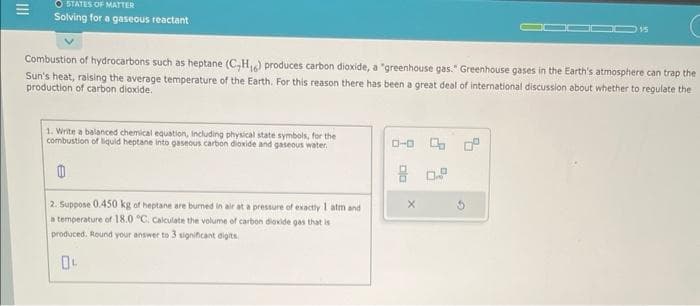Combustion of hydrocarbons such as heptane (C,H,) produces carbon dioxide, a "greenhouse gas." Greenhouse gases in the Earth's atmosphere can trap the Sun's heat, raising the average temperature of the Earth. For this reason there has been a great deal of international discussion about whether to regulate the production of carbon dioxide. 1. Write a balanced chemical equation, including physical state symbols, for the combustion of liquid heptane into gaseous carbon dioxide and gaseous water. 00 2. Suppose 0.450 kg of heptane are burned in air at a pressure of exactly 1 atm and i a temperature of 18.0 °C. Calculate the volume of carbon dioxide gas that is produced. Round your answer to 3 significant digits 04 0-0 0 0 80.2 X
Combustion of hydrocarbons such as heptane (C,H,) produces carbon dioxide, a "greenhouse gas." Greenhouse gases in the Earth's atmosphere can trap the Sun's heat, raising the average temperature of the Earth. For this reason there has been a great deal of international discussion about whether to regulate the production of carbon dioxide. 1. Write a balanced chemical equation, including physical state symbols, for the combustion of liquid heptane into gaseous carbon dioxide and gaseous water. 00 2. Suppose 0.450 kg of heptane are burned in air at a pressure of exactly 1 atm and i a temperature of 18.0 °C. Calculate the volume of carbon dioxide gas that is produced. Round your answer to 3 significant digits 04 0-0 0 0 80.2 X
Chemistry: Matter and Change
1st Edition
ISBN:9780078746376
Author:Dinah Zike, Laurel Dingrando, Nicholas Hainen, Cheryl Wistrom
Publisher:Dinah Zike, Laurel Dingrando, Nicholas Hainen, Cheryl Wistrom
Chapter11: Stoichiometry
Section: Chapter Questions
Problem 101A: Air Pollution Nitrogen monoxide, which is present in urban air pollution, immediately Converts to...
Related questions
Question

Transcribed Image Text:OSTATES OF MATTER
Solving for a gaseous reactant
Combustion of hydrocarbons such as heptane (C,H₁6) produces carbon dioxide, a "greenhouse gas." Greenhouse gases in the Earth's atmosphere can trap the
Sun's heat, raising the average temperature of the Earth. For this reason there has been a great deal of international discussion about whether to regulate the
production of carbon dioxide.
1. Write a balanced chemical equation, including physical state symbols, for the
combustion of liquid heptane into gaseous carbon dioxide and gaseous water.
0
2. Suppose 0.450 kg of heptane are burned in air at a pressure of exactly 1 atm and
a temperature of 18.0 °C. Calculate the volume of carbon dioxide gas that is
produced. Round your answer to 3 significant digits.
04
0-0 0.²°
80.7
Expert Solution
This question has been solved!
Explore an expertly crafted, step-by-step solution for a thorough understanding of key concepts.
Step by step
Solved in 5 steps

Knowledge Booster
Learn more about
Need a deep-dive on the concept behind this application? Look no further. Learn more about this topic, chemistry and related others by exploring similar questions and additional content below.Recommended textbooks for you

Chemistry: Matter and Change
Chemistry
ISBN:
9780078746376
Author:
Dinah Zike, Laurel Dingrando, Nicholas Hainen, Cheryl Wistrom
Publisher:
Glencoe/McGraw-Hill School Pub Co

Introductory Chemistry: An Active Learning Approa…
Chemistry
ISBN:
9781305079250
Author:
Mark S. Cracolice, Ed Peters
Publisher:
Cengage Learning

Introductory Chemistry: A Foundation
Chemistry
ISBN:
9781337399425
Author:
Steven S. Zumdahl, Donald J. DeCoste
Publisher:
Cengage Learning

Chemistry: Matter and Change
Chemistry
ISBN:
9780078746376
Author:
Dinah Zike, Laurel Dingrando, Nicholas Hainen, Cheryl Wistrom
Publisher:
Glencoe/McGraw-Hill School Pub Co

Introductory Chemistry: An Active Learning Approa…
Chemistry
ISBN:
9781305079250
Author:
Mark S. Cracolice, Ed Peters
Publisher:
Cengage Learning

Introductory Chemistry: A Foundation
Chemistry
ISBN:
9781337399425
Author:
Steven S. Zumdahl, Donald J. DeCoste
Publisher:
Cengage Learning

World of Chemistry, 3rd edition
Chemistry
ISBN:
9781133109655
Author:
Steven S. Zumdahl, Susan L. Zumdahl, Donald J. DeCoste
Publisher:
Brooks / Cole / Cengage Learning

Principles of Modern Chemistry
Chemistry
ISBN:
9781305079113
Author:
David W. Oxtoby, H. Pat Gillis, Laurie J. Butler
Publisher:
Cengage Learning

Chemistry: An Atoms First Approach
Chemistry
ISBN:
9781305079243
Author:
Steven S. Zumdahl, Susan A. Zumdahl
Publisher:
Cengage Learning